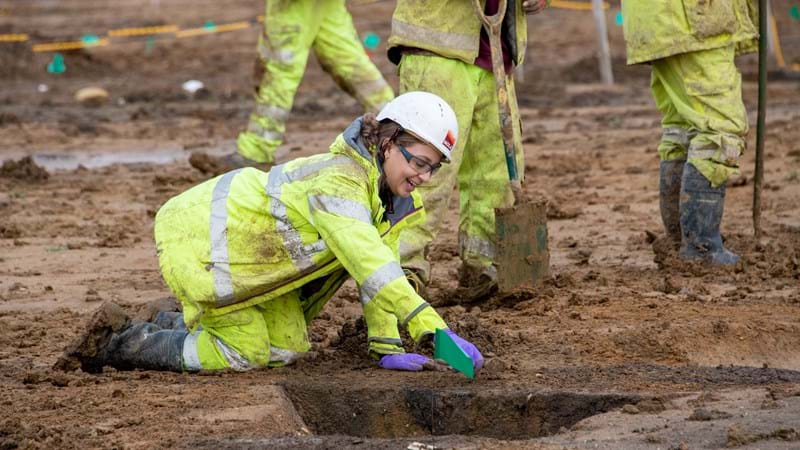Local wine and touchscreen tablets: fascinating finds on the A428
Published
17 Jul 2023
Read about the archaeological discoveries on the A428 that are helping experts understand life throughout British history…

Share this article
Headless animals, possible vineyards and a stylus are among the latest discoveries unearthed by archaeologists working on National Highways A428 Black Cat to Caxton Gibbet improvements, helping experts build a detailed picture of what life was like in Britain through history.
Since 2021, we have been working with archaeologists at the Museum of London Archaeology (MOLA) to build an incredibly detailed picture of what life was like in Bedfordshire and Cambridgeshire during the Iron Age (800 BC–AD 43) and Roman period (AD 43–410).
The team are investigating a vast area of land, the equivalent to 89 full-sized football pitches, making it one of the largest digs ever undertaken in the region. New discoveries continue to be made both in the field and the lab, providing clues about the lives of past inhabitants.
In the lab, environmental evidence is revealing luxuries were enjoyed by local people. Archaeologists may even have found grape pollen in cores taken from waterlogged soil, suggesting vineyards were grown in this area during the Roman period. Local people may not only have been enjoying locally produced beer (discovered in 2022), but also wine.
Experts have also been able to identify examples of Roman influence in the region. Artefacts recovered during excavations show how new goods were imported through the Roman trade network. Amphora—a type of ancient storage jar—may have brought olive oil to Cambridgeshire from Spain, and expensive dinnerware, named Samian ware, came from Northern France.
Remains of animals, including sheep and pigs, reveal much about people’s diets through history. Sometimes the way these remains were disposed of contain further clues, such as the mixture of bones and pottery dumped in two separate pits in different settlements – possible evidence of ancient feasts!
There have also been some surprises along the way, particularly in the form of a stylus. The Romans would have used it to write on their waxed tablets, just like modern day digital tablets. Styli (or styluses) were formed with a pointed end to write on the wax, and a trapezoidal one to erase the written words by smoothing the waxed surface flat again.
Until recently, the only objects known from this area dating before the Iron Age were stone arrowheads, suggesting small hunting groups roamed Cambridgeshire over 3,000 years ago. However, MOLA archaeologists have now found an unusual loom weight used in cloth making, which could date to the Bronze Age (2500–800 BC). If proven to be from this period, it would represent a very unexpected find and suggest people were living in this area far longer than originally believed.
Simon Markus, MOLA Project Manager, says “These excavations are super exciting, and give us the unusual opportunity to understand an entire ancient landscape. We make new discoveries every day and are passionate to share them with local communities across Bedfordshire and Cambridgeshire.”
Lorraine Bennetts, National Highways Senior Project Manager, says: “These incredible discoveries show us that Bedfordshire and Cambridgeshire were incredibly well connected with other regions across Great Britain and Europe. We are working with local schools and other local community groups to showcase these finds with craft workshops and virtual realisations so people can really understand our local history. We will continue to showcase our discoveries and learnings throughout the A428 Black Cat to Caxton Gibbet improvements.”
Sign up for updates
Keep updated on the A428 Black Cat to Caxton Gibbet improvements
Sign up for updates